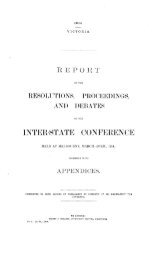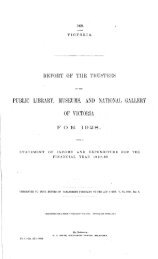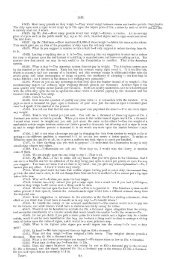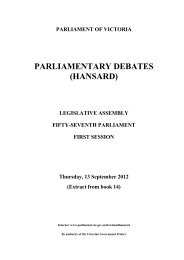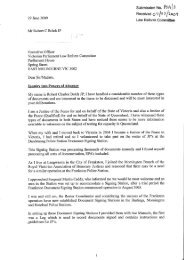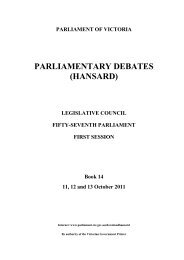Book 8 - Parliament of Victoria
Book 8 - Parliament of Victoria
Book 8 - Parliament of Victoria
Create successful ePaper yourself
Turn your PDF publications into a flip-book with our unique Google optimized e-Paper software.
FLOODS: WATER STORAGE MONITORING<br />
1652 COUNCIL Wednesday, 1 June 2011<br />
constraints <strong>of</strong> the design <strong>of</strong> these storages, including not<br />
compromising their primary function <strong>of</strong> water supply to<br />
urban and rural customers.<br />
Each water storage facility has a filling curve for the<br />
water authority to use a guide for maximum storage<br />
levels during the period from May to October.<br />
However, while the filling curve can provide flood<br />
mitigation benefits, its primary function is to maximise<br />
the storage potential for consumptive use. The<br />
government does not propose to change the design<br />
purpose <strong>of</strong> the major storages and is satisfied that the<br />
current internal review process being undertaken by<br />
rural water corporations will ensure that all practical<br />
steps will be taken to minimise floods to the greatest<br />
extent possible.<br />
It is important to remember that <strong>Victoria</strong> has only<br />
recently experienced its worst and longest drought on<br />
record — over 13 years — with a number <strong>of</strong> major<br />
irrigation storages being virtually emptied whilst others<br />
were drawn down to record low levels. During this<br />
period farmers experienced record low irrigation<br />
allocations, forcing many to abandon farming, and<br />
many towns faced prolonged periods <strong>of</strong> severe water<br />
restrictions. It is therefore imperative that any proposals<br />
to significantly increase flood mitigation beyond what<br />
is currently undertaken not compromise the reliability<br />
<strong>of</strong> existing entitlements, including supply to towns. The<br />
potential for flood mitigation that can be provided by<br />
storages varies significantly depending on the storage’s<br />
size in comparison to flood inflows, the design <strong>of</strong> the<br />
storage and whether the storage has the capacity to<br />
absorb the flood inflows. I would like to cite a few<br />
examples <strong>of</strong> how these factors affect flood mitigation.<br />
As Mr Barber knows, Lake Eildon is the only<br />
Goulburn-Murray Water storage which has a formal<br />
filling curve that is defined in the governing bulk<br />
entitlement. The purpose <strong>of</strong> the filling curve is to limit<br />
the risk <strong>of</strong> not filling the storage in the May to October<br />
period if releases are made to maintain airspace to<br />
provide additional flood mitigation benefits. The<br />
adopted risk is 5 per cent, and releases would be<br />
undertaken to prevent the storage filling to above the<br />
filling curve until October or November if conditions<br />
turn wet. Operating to the filling curve will provide<br />
approximately 300 000 megalitres <strong>of</strong> airspace to absorb<br />
floods in the following two months.<br />
Dams such as Lake Eppalock were built for water<br />
supply irrigation purposes, and as such they are<br />
managed to maximise the water resource available for<br />
water entitlement holders. The operations <strong>of</strong> the dams<br />
at lower levels to provide flood mitigation benefit<br />
would be at the expense <strong>of</strong> water entitlement reliability.<br />
Any change to that would require consultation with and<br />
possible compensation for the affected entitlement<br />
holders.<br />
Honourable members interjecting.<br />
Mr RAMSAY — Deputy President, is there another<br />
debate happening on the other side <strong>of</strong> the chamber?<br />
The ACTING PRESIDENT (Ms Crozier) —<br />
Order! I ask members on my left to make their<br />
conversations a little less audible.<br />
Mr RAMSAY — While Lake Eppalock is not<br />
operated to provide a flood mitigation benefit, by its<br />
very nature as a fixed-crest spillway it does provide<br />
significant flood mitigation. For instance, during the<br />
January 2011 event the instantaneous peak flow was<br />
approximately 140 000 megalitres per day. Due to the<br />
fixed-crest spillway creating surcharge volume in the<br />
lake, the peak outflow was reduced to<br />
80 000 megalitres per day.<br />
Mr Barber interjected.<br />
Mr RAMSAY — Surcharge, Mr Barber. GMW can<br />
only prerelease water when there is a high level <strong>of</strong><br />
certainty that the prerelease volume will be recovered<br />
by the end <strong>of</strong> the event — for example, if there was a<br />
reliable prediction <strong>of</strong> rainfall. Typically this would be<br />
based on a four-day Bureau <strong>of</strong> Meteorology forecast.<br />
Given the outlet capacity <strong>of</strong> only 1000 megalitres the<br />
day, this means that very little airspace can be created<br />
in the time following the prediction <strong>of</strong> rainfall before<br />
the event occurs.<br />
Lake Eppalock has a storage capacity <strong>of</strong> more than<br />
312 000 megalitres. The historic record shows great<br />
variability in inflows to Lake Eppalock. While there<br />
was unprecedented rain in January, there remains<br />
significant uncertainty as to the volume <strong>of</strong> inflow that<br />
might be received in the coming months. GMW has<br />
recently commenced work to review the impact on<br />
entitlements <strong>of</strong> operating within the greater airspace.<br />
The outcome <strong>of</strong> this work will be used to further inform<br />
discussion with key stakeholders in the community.<br />
Lake Buffalo and Cairn Curran Reservoir, the only<br />
other gated spillway storages within GMW, have local<br />
operating rules in place which are designed to manage<br />
the storage levels within the limits <strong>of</strong> the bulk<br />
entitlement. Local operating rules which allow for the<br />
creation <strong>of</strong> airspace are driven by dam safety<br />
considerations.<br />
Southern Rural Water has existing storage filling curves<br />
for Lake Glenmaggie, which still apply. However, it



